Nucleotide salvage
A salvage pathway is a pathway in which nucleotides (purine and pyrimidine) are synthesized from intermediates in the degradative pathway for nucleotides.
Salvage pathways are used to recover bases and nucleosides that are formed during degradation of RNA and DNA. This is important in some organs because some tissues cannot undergo de novo synthesis.
The salvaged bases and nucleosides can then be converted back into nucleotides. Salvage pathways are targets for drug development, one family being called antifolates.[1]
Substrates
The salvage pathway requires distinct substrates:
Pyrimidines
Uridine phosphorylase or pyrimidine-nucleoside phosphorylase adds ribose 1-phosphate to the free base uracil, forming uridine. Uridine kinase (aka uridine–cytidine kinase) can then phosphorylate this nucleoside into uridine monophosphate (UMP). UMP/CMP kinase (EC 2.7.4.14) can phosphorylate UMP into uridine diphosphate, which nucleoside diphosphate kinase can phosphorylate into uridine triphosphate.
Thymidine phosphorylase or pyrimidine-nucleoside phosphorylase adds 2-deoxy-alpha-D-ribose 1-phosphate to thymine, forming thymidine. Thymidine kinase can then phosphorylate this compound into thymidine monophosphate (TMP). Thymidylate kinase can phosphorylate TMP into thymidine diphosphate, which nucleoside diphosphate kinase can phosphorylate into thymidine triphosphate.
The nucleosides cytidine and deoxycytidine can be salvaged along the uracil pathway by cytidine deaminase, which converts them to uridine and deoxyuridine, respectively. Alternatively, uridine–cytidine kinase can phosphorylate them into cytidine monophosphate (CMP) or deoxycytidine monophosphate (dCMP). UMP/CMP kinase can phosphorylate (d)CMP into cytidine diphosphate or deoxycytidine diphosphate, which nucleoside diphosphate kinase can phosphorylate into cytidine triphosphate or deoxycytidine triphosphate.

Purines
Phosphoribosyltransferases add activated ribose-5-phosphate (Phosphoribosyl pyrophosphate, PRPP) to bases, creating nucleoside monophosphates. There are two types of phosphoribosyltransferases: adenine phosphoribosyltransferase (APRT) and hypoxanthine-guanine phosphoribosyltransferase (HGPRT). HGPRT is an important enzyme in Purine pathway metabolism and[2] its deficiency is implicated in Lesch-Nyhan syndrome.
| Nucleobase | Enzyme | Nucleotide |
| hypoxanthine | hypoxanthine/guanine phosphoribosyl transferase (HGPRT) | IMP |
| guanine | hypoxanthine/guanine phosphoribosyl transferase (HGPRT) | GMP |
| adenine | adenine phosphoribosyltransferase (APRT) | AMP |
Folate biosynthesis
Tetrahydrofolic acid and its derivatives are produced by salvage pathways from GTP.[1]
References
- 1 2 Ivan M. Kompis, Khalid Islam, Rudolf L. Then (2005). "DNA and RNA Synthesis: Antifolates". Chem. Rev. 105: 593–620. doi:10.1021/cr0301144.
- ↑ Ansari MY, Equbal A, Dikhit MR, Mansuri R, Rana S, Ali V, Sahoo GC, Das P (Nov 2015). "Establishment of Correlation between In-Silico &In-Vitro Test Analysis against Leishmania HGPRT to inhibitors". International Journal of Biological Macromolecules. 83: 78–96. doi:10.1016/j.ijbiomac.2015.11.051. PMID 26616453.